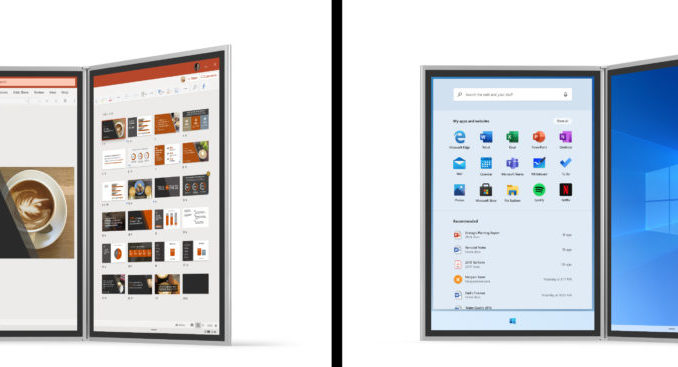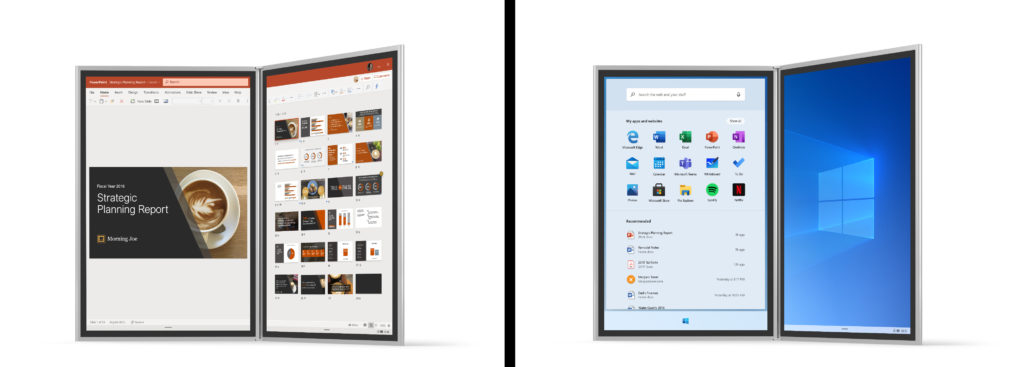
Introducing Windows 10X: enabling dual-screen PCs in 2020

[Pre-release product shown, screens simulated and subject to change]
Windows 10 is now on more than 900 million devices and we want to thank all of our customers around the world who use Windows 10 every day. Whether it is to run your business, browse the web, collaborate on documents, play games, create or learn, you inspire us and push us to continue to innovate and improve Windows 10. As long as we have been building it, Windows has also evolved based on the possibilities enabled by hardware innovation. Both with Surface and our ecosystem partners, we strive to bring the best of hardware and software together into experiences that better serve your needs.
Windows 10X: designed for dual-screen PCs
Today in New York we took another step in that journey and shared our vision for a brand-new category of dual-screen devices, including a sneak peek of Surface Neo, soon to be followed by devices from ASUS, Dell, HP and Lenovo. People are expecting more flexibility from their PCs—they want performant, highly flexible, fully capable and compatible devices that are at the same time delivered in a simple, sleek and, increasingly, mobile form factor. This new hardware requires an expression of Windows 10 that evolves to meet this opportunity. This is Windows 10X.
Windows 10X is the best of Windows 10 built to enable unique experiences on multi-posture dual-screen PCs. We have taken the Windows 10 that customers know and love and built Windows 10X in a way that marries the familiar with the new.
Flexible postures: meeting the increasingly mobile needs of today
Between work and family, our time is precious. With a dual-screen PC and Windows 10X, people can get things done on-the-go faster than ever: take notes on one screen while reviewing the full project proposal on the other while in transit; sit down at a table to write a thoughtful email on a hardware keyboard while waiting for lunch; and then watch a video, browse the web or read a book as you get back to your life.
For our commercial customers, we think this experience appeals to mobile professionals who want a device that can keep up when they’re on the go. We see these people looking at multiple charts and data at the same time to study complex problems or viewing a presentation on one screen while on a call and seeing the meeting participants in full video on the other, or having a reference article open while commenting on a document.
Technical approach: investing in Windows 10 with enhancements supporting dual screen under the hood
Fans of Windows 10 today will be able to use Windows 10X with practically no learning curve. The navigation and functionality will feel familiar and a Windows 10X PC will feel like a natural member of today’s Windows 10 family.
But Windows 10X also includes some advancements in the core technology of Windows that optimize it for flexible postures and more mobile use. We needed to deliver battery life that could drive not just one, but two screens. We wanted the operating system to be able to manage the battery effect of our huge catalog of Windows apps, whether they were written in the last month or five years ago. And we wanted to deliver the hardware performance and compatibility our customers expect from Windows 10.
To accomplish these goals, we didn’t wipe the slate clean and start over with a brand-new operating system. Our approach is an evolution of where we’ve been going with Windows 10 for the last few years.
For those of you not familiar, there are a common set of shared technologies in Windows 10 that unlock a whole host of devices across the spectrum from consumers to businesses and industries. Internally, we call these shared technologies “one core” but what matters most to customers is what they enable. Today, we build desktop PCs, Xbox consoles and HoloLens using this technology. Windows 10X joins the family, built on the latest investments in these shared technologies including newly implemented support for running Win32 applications in a container. This, together with further componentization and additional investments, gives us the power to deliver more flexible experiences with a wide range of input types and hardware postures all while managing Windows applications and how they use the battery. It also has the added benefit of allowing us to innovate in the shared technologies and quickly bring these across the devices built on top of them, allowing us to accelerate how innovation reaches the largest number of customers across a vast array of devices.
Availability, timing and ecosystem support
Windows 10X will be available on dual-screen and foldable devices starting in the fall of 2020, in time for the holiday season. These will include both Microsoft Surface and devices from several Windows ecosystem partners including ASUS, Dell, HP and Lenovo. The first wave of devices will vary in size, design and specs, and be powered by Intel.
Windows 10X is designed for new dual-screen PCs and not as an OS upgrade if you already own a PC. We are also continuously investing in improving the Windows 10 experience on desktops and laptops, while Windows 10X will enable a new class of PCs that will complement and co-exist with today’s Windows 10 PCs. And with the holidays coming up, there are more innovative Windows 10 PCs available than ever before including the broadest Surface line-up announced today in New York along with devices from all of our OEM partners.
We’ll also be engaging with our app developer ecosystem as Windows 10X presents unique opportunities for them to enrich their experiences with dual-screen PCs. We’ll have more to share on that in the coming months.
Thank you for your support of and interest in Windows!
We’re still in the early stages of this work but we couldn’t be more excited for what the future holds. We’ll continue to listen, learn and adjust as we work towards next year. We cannot wait for everyone to experience how we continue to evolve Windows 10 for desktop PCs and now with Windows 10X for dual screens.
The post Introducing Windows 10X: enabling dual-screen PCs in 2020 appeared first on Windows Blog.
Source: Introducing Windows 10X: enabling dual-screen PCs in 2020







Leave a Reply